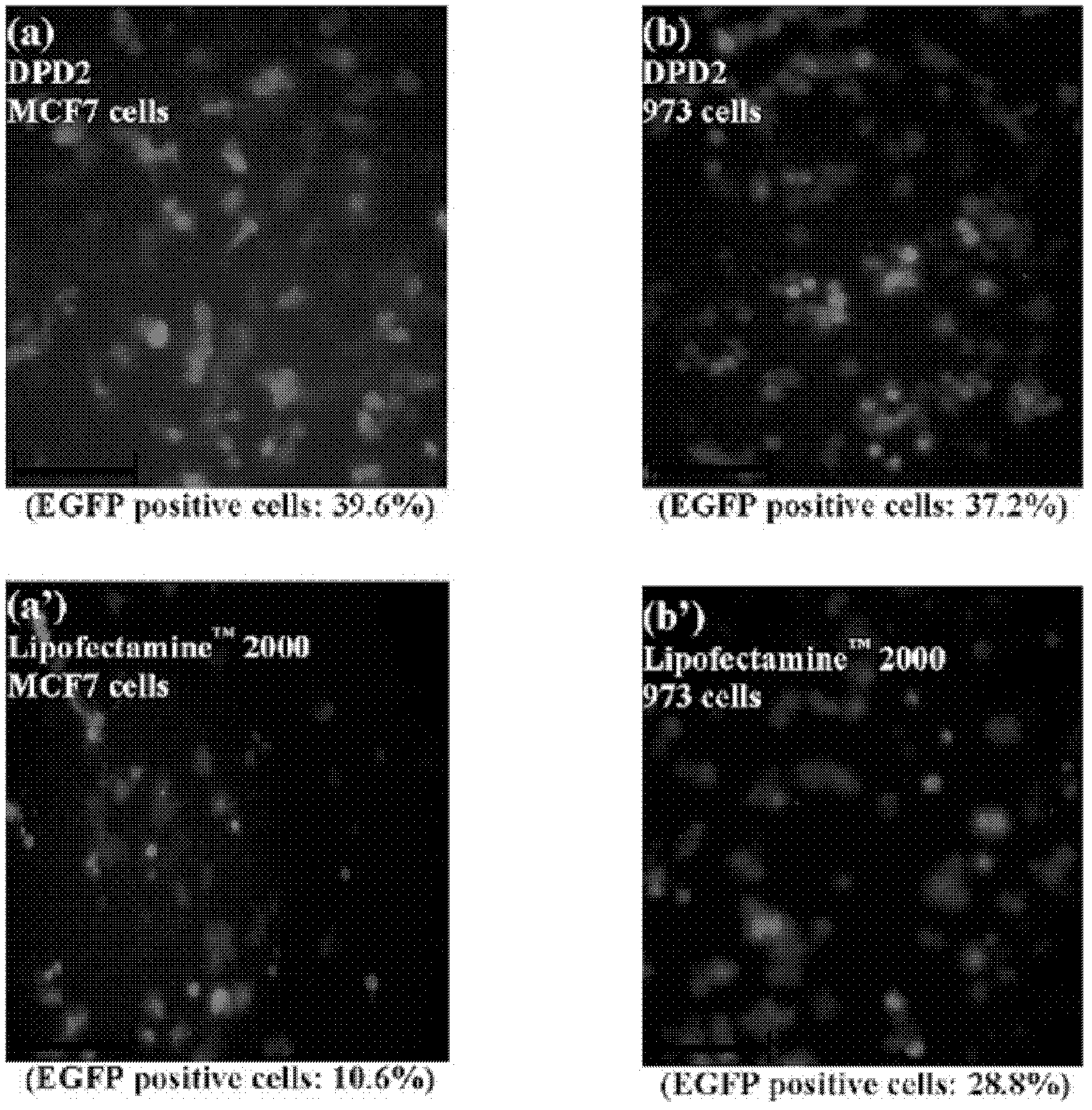Construction of bio-reducible efficient cation gene vectors taking polysaccharides as frameworks with ATRP (Atom Transfer Radical Polymerization) method
A gene carrier and cationic technology, applied in the field of bioreducible cationic polysaccharide gene carrier, can solve the problems of different protonation ability and carrier transfection efficiency, and achieve the effect of easy regulation, simple use method and good storage stability
- Summary
- Abstract
- Description
- Claims
- Application Information
AI Technical Summary
Problems solved by technology
Method used
Image
Examples
Embodiment 1
[0040] Continuous reaction under nitrogen protection conditions at 25°C, add 0.1g dextran macromolecular initiator (recorded as SS-Dextran-Br) into methanol to dissolve, then add water, N,N-dimethylaminoethyl methacrylate in sequence (DMEMA), 2,2-bipyridine, and finally add CuBr to initiate active controlled free radical polymerization, wherein water / SS-Dextran-Br=30 (mass ratio), methanol / SS-Dextran-Br=20 (mass ratio) , DMEMA / SS-Dextran-Br=10 (mass ratio), 2,2-bipyridine / SS-Dextran-Br=0.36 (mass ratio), CuBr / SS-Dextran-Br=0.18 (mass ratio); after 5min Open the bottle stopper to accelerate stirring for 10 minutes, fully contact with air to stop the reaction; the polymer product is repeatedly precipitated with ether until the shape becomes solid, and then put it in a vacuum drying oven to remove the ether; then dissolve the product in 40ml of water and put it in a Put it in a dialysis bag, then transfer it to a 5L beaker and fill it with deionized water to start dialysis for 6 ...
Embodiment 2
[0043] Continue the reaction under nitrogen protection at 25°C, dissolve 0.1g of dextran macroinitiator (referred to as SS-Dextran-Br) in methanol, then add water, N,N-dimethylaminoethyl methacrylate in sequence (DMEMA), 2,2-bipyridine and CuBr initiate active controllable radical polymerization, the reaction conditions and the post-treatment method of the polymerized product are the same as in Example 1, except that the reaction time is 30min, and the bioreducible cationic gene with polysaccharide as the skeleton is obtained. 0.3 g of the carrier is recorded as a polymer (SS-Dextran-PDMEMA), its Mn is 102000, and its Mw / Mn is 1.80.
[0044] The skeleton structure of SS-Dextran-Br is dextran with a molecular weight of 20,000-25,000, and the hydroxyl groups on it are replaced by groups of the following structural formula
[0045] The above-mentioned bioreducible cationic gene carrier with polysaccharide as the backbone is denoted as DPD2, and its transfection efficiency is de...
Embodiment 3
[0047] Continuous reaction in an oxygen-free environment at 25°C, dissolve 0.1g dextran macroinitiator (referred to as SS-Dextran-Br) in dimethyl sulfoxide (DMSO), and then add glycidyl methacrylate in sequence (GMA), CuBr, CuBr 2 , and finally add pentamethyldiethylenetriamine (PMDTETA) to initiate living controllable radical polymerization, wherein dimethyl sulfoxide (DMSO) / SS-Dextran-Br=100 (mass ratio), glycidyl methacrylate ( GMA) / SS-Dextran-Br=40 (mass ratio), CuBr / SS-Dextran-Br=0.33 (mass ratio), CuBr 2 / SS-Dextran-Br=0.06 (mass ratio), pentamethyldiethylenetriamine (PMDTETA) / SS-Dextran-Br=0.5 (mass ratio); after 15min, open the cork and pour the liquid in the bottle slowly into the Prepare a beaker with 200mL of methanol, stir at high speed to stop the reaction, then add 200mL of methanol to precipitate the product, and then put it in a vacuum oven to remove methanol; dissolve the product in 40ml of water and put it in a dialysis bag with a molecular weight cut-off of...
PUM
| Property | Measurement | Unit |
|---|---|---|
| molecular weight distribution | aaaaa | aaaaa |
| dispersity | aaaaa | aaaaa |
| dispersity | aaaaa | aaaaa |
Abstract
Description
Claims
Application Information
 Login to View More
Login to View More - R&D Engineer
- R&D Manager
- IP Professional
- Industry Leading Data Capabilities
- Powerful AI technology
- Patent DNA Extraction
Browse by: Latest US Patents, China's latest patents, Technical Efficacy Thesaurus, Application Domain, Technology Topic, Popular Technical Reports.
© 2024 PatSnap. All rights reserved.Legal|Privacy policy|Modern Slavery Act Transparency Statement|Sitemap|About US| Contact US: help@patsnap.com









